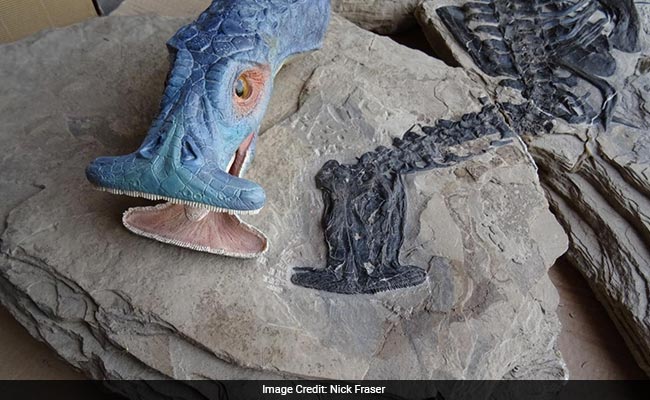
The fossilized cranium and a model reconstruction.
not all clinical insights require a $1.1-billion experiment to take a look at gravity waves, or call for amassive particle collider be buried underneath Europe. from time to time all that is wished are a couple of bucks well worth of modeling clay and toothpicks — and, well, a pair of priceless 250-million-year–vintage fossils.
The fossils in query consist of an uncommon reptilian cranium, small but ending in a unexpectedlyflaring mouth, just like the face of a hammerhead shark or a fleshy harmonica. inside the extraordinarymaw had been rows and rows of needle enamel, stumping the paleontologists who had unearthed it whereina sea as soon as included components of China, hundreds of thousands of years in the past.
The breakthrough came after they determined to reconstruct the creature’s head in brightly-coloured putty. “The jaw association could be very unusual, and we needed to be sure that speculation as to how the jaw could close absolutely could work,” said Nick Fraser, an professional on Triassic animals at thecountry wide Museum of Scotland and an creator of a take a look at these days published inside themagazine science Advances, told The Washington put up.
The reptile used its flared mouth to scrape away algae and vegetation from submerged rocks, and then it sucked down the watery blend. ” with the aid of gulping in this liquid blend of plant matter and sea water, the animal should close its mouth,” Fraser stated, “and, the use of its tongue, force the water out of theaspect off the mouth and throughout the clear out formed by means of the needle-formed tooth.” Thefinal clue changed into a row of chisel-like tooth on the main fringe of the jaw, that are just like the onesof dinosaurs believed to have eaten vegetation. (Atopodentatus unicus wasn’t a dinosaur, however — thosemight arrive some million years later.)
The paintings through Fraser and his colleagues overturn a 2014 speculation that a. unicus changed intoeven greater weird. A previously–observed specimen regarded to have a bifurcated snout that in shapetogether vertically, like the enamel of a zipper. That struck Li Chun, an author of the science Advances fileand a paleontologist at Institute of Vertebrate Paleontology and Paleoanthropology in China, as a piecefarfetched — even for the weirdness of the early Triassic period. In his view, Li wrote to The Washington put up in an electronic mail, the 2014 cranium was beaten and too badly preserved reconstruct its uniquestructure.
Fraser stated he is aware how the primary paleontologists ended up at the wrong conclusion. way to the pair of recent fossils, which appear to be in a good deal better condition, Fraser’s assured this model istoward the reality. “we are sure we have this particular thing of the animal successfully.” there is stilllots of thriller left, but: no one is aware of what the a juvenile Atopodentatus turned into like, or how they mated.
Even without a vertical zipper mouth, Atopodentatus unicus continues to be an extraordinary beast. There are only a few reptilian herbivores within the sea — current-day examples consist of the marine iguana, thegreen turtle and now not a whole lot else.
To pay attention Fraser tell it, Atopodentatus unicus owed its particular life to loss of life — and masses of it. The reptile lived in the early Triassic, within the wake of the Permian extinction event. acknowledgedalso as the excellent loss of life, the Permian extinction turned into a factor in time when 9 in each 10 marine species vanished. Many formerly–complete ecological niches have been left extensive open, prompting an evolutionary unfastened-for-all, which include Atopodentatus unicus and the tusked mammal ancestor Dicynodon .
“You had a wiping of the slate,” Fraser said, and then a period of biological experimentation. “there wasan explosion of recent life forms, and they had been crazy.”
© 2016 The Washington put up
(This story has no longer been edited by means of NDTV body of workers and is auto-generated from a syndicated feed.)




